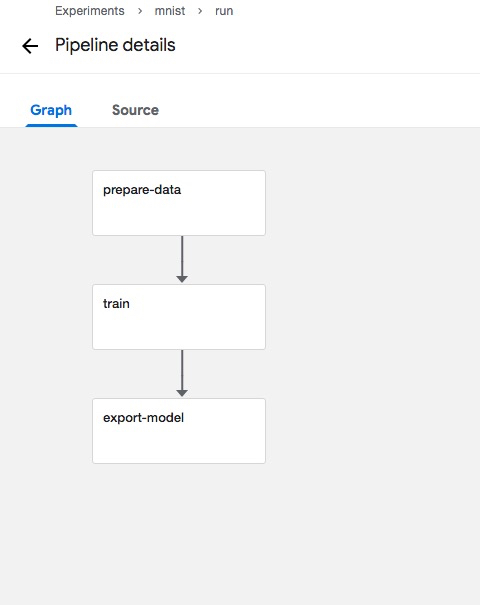按照上篇文章搭建了一套Kubeflow Pipelines之后,我们一起小试牛刀,用一个真实的案例,学习如何开发一套基于Kubeflow Pipelines的机器学习工作流。
准备工作
机器学习工作流是一个任务驱动的流程,同时也是数据驱动的流程,这里涉及到数据的导入和准备,模型训练Checkpoint的导出评估,到最终模型的导出。这就需要分布式存储作为传输的媒介,这里使用NAS作为分布式存储。
- 创建分布式存储,这里以NAS为例。这里
NFS_SERVER_IP需要替换成真实NAS服务器地址
1.创建阿里云NAS服务,可以参考文档
2.需要在 NFS Server 中创建 /data
# mkdir -p /nfs
# mount -t nfs -o vers=4.0 NFS_SERVER_IP:/ /nfs
# mkdir -p /data
# cd /
# umount /nfs3.创建对应的Persistent Volume.
# cat nfs-pv.yaml
apiVersion: v1
kind: PersistentVolume
metadata:
name: user-susan
labels:
user-susan: pipelines
spec:
persistentVolumeReclaimPolicy: Retain
capacity:
storage: 10Gi
accessModes:
- ReadWriteMany
nfs:
server: NFS_SERVER_IP
path: "/data"
# kubectl create -f nfs-pv.yaml4.创建Persistent Volume Claim
# cat nfs-pvc.yaml
apiVersion: v1
kind: PersistentVolumeClaim
metadata:
name: user-susan
annotations:
description: "this is the mnist demo"
owner: Tom
spec:
accessModes:
- ReadWriteMany
resources:
requests:
storage: 5Gi
selector:
matchLabels:
user-susan: pipelines
# kubectl create -f nfs-pvc.yaml开发Pipeline
由于Kubeflow Pipelines提供的例子都是依赖于Google的存储服务,这导致国内的用户无法真正体验Pipelines的能力。阿里云容器服务团队提供了训练MNIST模型的例子,方便您在阿里云上使用和学习Kubeflow Pipelines。具体步骤为3步:
(1)下载数据
(2)利用TensorFlow进行模型训练
(3)模型导出
这3个步骤中后一个步骤都依赖与前一个步骤完成。
在Kubeflow Pipelines中可以用Python代码描述了这样一个流程, 完整代码可以查看standalone_pipeline.py。我们在这个例子中使用了arena_op这是对于Kubeflow默认的container_op封装,能够实现对于分布式训练MPI和PS模式的无缝衔接,另外也支持使用GPU和RDMA等异构设备和分布式存储的简单接入,同时也方便从git源同步代码。是一个比较实用的工具API。而arena_op是基于开源项目Arena。
@dsl.pipeline(
name='pipeline to run jobs',
description='shows how to run pipeline jobs.'
)
def sample_pipeline(learning_rate='0.01',
dropout='0.9',
model_version='1',
commit='f097575656f927d86d99dd64931042e1a9003cb2'):
"""A pipeline for end to end machine learning workflow."""
data=["user-susan:/training"]
gpus=1
# 1. prepare data
prepare_data = arena.standalone_job_op(
name="prepare-data",
image="byrnedo/alpine-curl",
data=data,
command="mkdir -p /training/dataset/mnist && \
cd /training/dataset/mnist && \
curl -O https://code.aliyun.com/xiaozhou/tensorflow-sample-code/raw/master/data/t10k-images-idx3-ubyte.gz && \
curl -O https://code.aliyun.com/xiaozhou/tensorflow-sample-code/raw/master/data/t10k-labels-idx1-ubyte.gz && \
curl -O https://code.aliyun.com/xiaozhou/tensorflow-sample-code/raw/master/data/train-images-idx3-ubyte.gz && \
curl -O https://code.aliyun.com/xiaozhou/tensorflow-sample-code/raw/master/data/train-labels-idx1-ubyte.gz")
# 2. downalod source code and train the models
train = arena.standalone_job_op(
name="train",
image="tensorflow/tensorflow:1.11.0-gpu-py3",
sync_source="https://code.aliyun.com/xiaozhou/tensorflow-sample-code.git",
env=["GIT_SYNC_REV=%s" % (commit)],
gpus=gpus,
data=data,
command='''
echo %s;python code/tensorflow-sample-code/tfjob/docker/mnist/main.py \
--max_steps 500 --data_dir /training/dataset/mnist \
--log_dir /training/output/mnist --learning_rate %s \
--dropout %s''' % (prepare_data.output, learning_rate, dropout),
metrics=["Train-accuracy:PERCENTAGE"])
# 3. export the model
export_model = arena.standalone_job_op(
name="export-model",
image="tensorflow/tensorflow:1.11.0-py3",
sync_source="https://code.aliyun.com/xiaozhou/tensorflow-sample-code.git",
env=["GIT_SYNC_REV=%s" % (commit)],
data=data,
command="echo %s;python code/tensorflow-sample-code/tfjob/docker/mnist/export_model.py --model_version=%s --checkpoint_path=/training/output/mnist /training/output/models" % (train.output, model_version))Kubeflow Pipelines会将上面的代码转化成一个有向无环图(DAG),其中的每一个节点就是Component(组件),而Component(组件)之间的连线代表它们之间的依赖关系。从Pipelines UI可以看到DAG图:

首先具体理解一下数据准备的部分,这里我们提供了arena.standalone_job_op的Python API, 需要指定该步骤的名称:name,需要使用的容器镜像:image,要使用的数据以及其对应到容器内部的挂载目录:data,这里的data是一个数组格式, 如data=["user-susan:/training"],表示可以挂载到多个数据。 user-susan是之前创建的Persistent Volume Claim,而/training为容器内部的挂载目录。
prepare_data = arena.standalone_job_op(
name="prepare-data",
image="byrnedo/alpine-curl",
data=data,
command="mkdir -p /training/dataset/mnist && \
cd /training/dataset/mnist && \
curl -O https://code.aliyun.com/xiaozhou/tensorflow-sample-code/raw/master/data/t10k-images-idx3-ubyte.gz && \
curl -O https://code.aliyun.com/xiaozhou/tensorflow-sample-code/raw/master/data/t10k-labels-idx1-ubyte.gz && \
curl -O https://code.aliyun.com/xiaozhou/tensorflow-sample-code/raw/master/data/train-images-idx3-ubyte.gz && \
curl -O https://code.aliyun.com/xiaozhou/tensorflow-sample-code/raw/master/data/train-labels-idx1-ubyte.gz")而上述步骤实际上是从指定地址利用curl下载数据到分布式存储对应的目录/training/dataset/mnist,请注意这里的/training为分布式存储的根目录,类似大家熟悉的根mount点;而/training/dataset/mnist是子目录。其实后面的步骤可以通过使用同样的根mount点,读到数据,进行运算。
第二步是利用下载到分布式存储的数据,并通过git指定固定commit id下载代码,并进行模型训练
train = arena.standalone_job_op(
name="train",
image="tensorflow/tensorflow:1.11.0-gpu-py3",
sync_source="https://code.aliyun.com/xiaozhou/tensorflow-sample-code.git",
env=["GIT_SYNC_REV=%s" % (commit)],
gpus=gpus,
data=data,
command='''
echo %s;python code/tensorflow-sample-code/tfjob/docker/mnist/main.py \
--max_steps 500 --data_dir /training/dataset/mnist \
--log_dir /training/output/mnist --learning_rate %s \
--dropout %s''' % (prepare_data.output, learning_rate, dropout),
metrics=["Train-accuracy:PERCENTAGE"])可以看到这个步骤比数据准备要相对复杂一点,除了和第一步骤中的name,image, data和command之外,在模型训练步骤中,还需要指定:
- 获取代码的方式: 从可重现实验的角度来看,对于运行试验代码的追本溯源,是非常重要的一环。可以在API调用时指定
sync_source的git代码源,同时通过设定env中GIT_SYNC_REV指定训练代码的commit id - gpu: 默认为0,就是不使用GPU;如果为大于0的整数值,就代表该步骤需要这个数量的GPU数。
- metrics: 同样是从可重现和可比较的实验目的出发,用户可以将需要的一系列指标导出,并且通过Pipelines UI上直观的显示和比较。具体使用方法分为两步,1.在调用API时以数组的形式指定要收集指标的metrics name和指标的展示格式PERCENTAGE或者是RAW,比如
metrics=["Train-accuracy:PERCENTAGE"]。2.由于Pipelines默认会从stdout日志中收集指标,你需要在真正运行的模型代码中输出{metrics name}={value}或者{metrics name}:{value}, 可以参考具体样例代码


值得注意的是:
在本步骤中指定了和
prepare_data相同的data参数["user-susan:/training"],就可以在训练代码中读到对应的数据,比如--data_dir /training/dataset/mnist,另外由于该步骤依赖于
prepare_data,可以在方法中通过指定prepare_data.output表示两个步骤的依赖关系。
最后export_model是基于train训练产生的checkpoint,生成训练模型:
export_model = arena.standalone_job_op(
name="export-model",
image="tensorflow/tensorflow:1.11.0-py3",
sync_source="https://code.aliyun.com/xiaozhou/tensorflow-sample-code.git",
env=["GIT_SYNC_REV=%s" % (commit)],
data=data,
command="echo %s;python code/tensorflow-sample-code/tfjob/docker/mnist/export_model.py --model_version=%s --checkpoint_path=/training/output/mnist /training/output/models" % (train.output, model_version))export_model和第二步train类似,甚至要更为简单,它只是从git同步模型导出代码并且利用共享目录/training/output/mnist中的checkpoint执行模型导出。
整个工作流程看起来还是很直观的, 下面就可以定义一个Python方法将整个流程贯穿在一起。
@dsl.pipeline(
name='pipeline to run jobs',
description='shows how to run pipeline jobs.'
)
def sample_pipeline(learning_rate='0.01',
dropout='0.9',
model_version='1',
commit='f097575656f927d86d99dd64931042e1a9003cb2'):@dsl.pipeline是表示工作流的装饰器,这个装饰器中需要定义两个属性,分别是
name和description入口方法
sample_pipeline中定义了4个参数learning_rate,dropout,model_version和commit,分别可以在上面的train和export_model阶段使用。这里的参数的值实际上是 dsl.PipelineParam类型,定义成dsl.PipelineParam的目的在于可以通过Kubeflow Pipelines的原生UI可以将其转换成输入表单,表单的关键字是参数名称,而默认值为参数的值. 值得注意的是,这里的dsl.PipelineParam对应值的实际上只能是字符串和数字型;而数组和map,以及自定义类型都是无法通过转型进行变换的。
而实际上,这些参数都可以在用户提交工作流时进行覆盖,以下就是提交工作流对应的UI:


提交Pipeline
您可以在自己的Kubernetes内将前面开发工作流的Python DSL提交到Kubeflow Pipelines服务中, 实际提交代码很简单:
KFP_SERVICE="ml-pipeline.kubeflow.svc.cluster.local:8888"
import kfp.compiler as compiler
compiler.Compiler().compile(sample_pipeline, __file__ + '.tar.gz')
client = kfp.Client(host=KFP_SERVICE)
try:
experiment_id = client.get_experiment(experiment_name=EXPERIMENT_NAME).id
except:
experiment_id = client.create_experiment(EXPERIMENT_NAME).id
run = client.run_pipeline(experiment_id, RUN_ID, __file__ + '.tar.gz',
params={'learning_rate':learning_rate,
'dropout':dropout,
'model_version':model_version,
'commit':commit})利用
compiler.compile将Python代码编译成执行引擎(Argo)识别的DAG配置文件通过Kubeflow Pipeline的客户端创建或者找到已有的实验,并且提交之前编译出的DAG配置文件
在集群内准备一个python3的环境,并且安装Kubeflow Pipelines SDK
# kubectl create job pipeline-client --namespace kubeflow --image python:3 -- sleep infinity
# kubectl exec -it -n kubeflow $(kubectl get po -l job-name=pipeline-client -n kubeflow | grep -v NAME| awk '{print $1}') bash
登录到Python3的环境后,执行如下命令,连续提交两个不同参数的任务
# pip3 install http://kubeflow.oss-cn-beijing.aliyuncs.com/kfp/0.1.14/kfp.tar.gz --upgrade
# pip3 install http://kubeflow.oss-cn-beijing.aliyuncs.com/kfp-arena/kfp-arena-0.4.tar.gz --upgrade
# curl -O https://raw.githubusercontent.com/cheyang/pipelines/update_standalone_sample/samples/arena-samples/standalonejob/standalone_pipeline.py
# python3 standalone_pipeline.py --learning_rate 0.0001 --dropout 0.8 --model_version 2
# python3 standalone_pipeline.py --learning_rate 0.0005 --dropout 0.8 --model_version 3查看运行结果
登录到Kubeflow Pipelines的UI: https://{pipeline地址}/pipeline/#/experiments, 比如
https://11.124.285.171/pipeline/#/experiments

点击Compare runs按钮,可以比较两个实验的输入,花费的时间和精度等一系列指标。让实验可追溯是让实验可重现的第一步;而利用Kubeflow Pipelines本身的实验管理能力则是开启实验可重现的第一步。


总结
实现一个可以运行的Kubeflow Pipeline需要的步骤是:
1.构建Pipeline(流水线)中需要的最小执行单元Component(组件),如果是利用原生定义的dsl.container_ops,需要构建两部分代码:
- 构建运行时代码:通常是为每个步骤构建容器镜像,作为Pipelines和真正执行业务逻辑代码之间的适配器。它所做的事情为获取Pipelines上下文的输入参数,调用业务逻辑代码,并且将需要传递到下个步骤的输出按照Pipelines的规则放到容器内的指定位置,由底层工作流组件负责传递。 这样产生的结果是运行时代码与业务逻辑代码会耦合在一起。可以参考Kubeflow Pipelines的例子
- 构建客户端代码:这个步骤通常是长成下面的样子, 熟悉Kubernetes的朋友会发现这个步骤实际上就是在编写Pod Spec:
container_op = dsl.ContainerOp(
name=name,
image='<train-image>',
arguments=[
'--input_dir', input_dir,
'--output_dir', output_dir,
'--model_name', model_name,
'--model_version', model_version,
'--epochs', epochs
],
file_outputs={'output': '/output.txt'}
)
container_op.add_volume(k8s_client.V1Volume(
host_path=k8s_client.V1HostPathVolumeSource(
path=persistent_volume_path),
name=persistent_volume_name))
container_op.add_volume_mount(k8s_client.V1VolumeMount(
mount_path=persistent_volume_path,
name=persistent_volume_name))利用原生定义的dsl.container_ops的好处在于灵活,由于开放了和Pipelines的交互接口,用户可以在container_ops这个层面做许多事情。但是它的问题在于:
- 复用度低,每个Component都需要构建镜像和开发运行时代码
- 复杂度高,使用者需要了解Kubernetes的概念,比如resource limit, PVC, node selector等一系列概念
- 支持分布式训练困难,由于
container_op为单容器操作,如果需要支持分布式训练就需要在container_ops中提交和管理类似TFJob的任务。这里会带来复杂度和安全性的双重挑战,复杂度比较好理解,安全性是说提交TFJob这类任务的权限会需要开放额外的权限给Pipeline的开发者。
另一种方式是使用arena_op这种可以重用的Component API,它使用通用运行时代码,可以免去重复构建运行时代码的工作;同时利用通用一套的arena_op API简化用户的使用;也支持Parameter Server和MPI等场景。建议您使用这种方式编译Pipelines
2.将构建好的Component(组件)拼接成Pipeline(流水线)
3.将Pipeline(流水线)编译后Argo的执行引擎(Argo)识别的DAG配置文件, 并提交的DAG配置文件到Kubeflow Pipelines, 并利用Kubeflow Pipelines自身的UI查看流程结果。